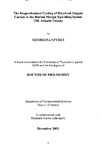The Biogeochemical Cycling of Dissolved Organic Carbon in the Iberian Margin Upwelling System (NE Atlantic Ocean
| dc.contributor.author | Spyres, Geogina | |
| dc.contributor.other | Faculty of Science and Engineering | en_US |
| dc.date.accessioned | 2013-09-16T12:44:32Z | |
| dc.date.available | 2013-09-16T12:44:32Z | |
| dc.date.issued | 2001 | |
| dc.identifier | NOT AVAILABLE | en_US |
| dc.identifier.uri | http://hdl.handle.net/10026.1/1766 | |
| dc.description | Merged with duplicate record 10026.1/2368 on 14.03.2017 by CS (TIS) | |
| dc.description.abstract |
Dissolved organic carbon (DOC) is the quantitatively most important organic carbon reservoir in the world's oceans and its determination at ocean margins, where the exchange of terrestrial and oceanic organic matter occurs, is important for estimating cross-slope fluxes to deep waters. With the increased accuracy and precision (-1%) of analytical methodologies, small changes in the DOC pool can be detected (i.e. 1- 2uM-C). This study investigated the biogeochemical cycling of DOC at the Iberian Margin upwelling system (42-43°N, --9-10°W), where contrasting seasonal hydrologic phenomena occur (e.g. summer upwelling, winter poleward current). Spatial and temporal DOC distributions were determined using high temperature catalytic oxidation (HTCO) techniques. DOC concentrations generally decreased with distance from the continental shelf and with increasing depth, although localised accumulation was observed in surface as well as in deep waters with a mean excess of up to 16 uM-C over background concentrations (57 uM-C). DOC concentrations in surface waters were closely associated with bacterial productivity and dissolved organic nitrogen (DON) production was facilitated by photosynthetic extra-cellular release from phytoplankton. There was no marked difference in DOC concentrations between the summer and winter seasons due to increased mineralization during the summer and lateral inputs during the winter. DOC production exceeded removal rates in summer upwelled surface waters following enhanced biological activity, in the winter surface poleward current and in deep waters that contained high levels of suspended particulates. DOC from terrestrial run-off was recycled rapidly at the coast before it could be exported to the shelf Cross-slope export of accumulated DOC was generally hindered by the net onshore velocity component during both winter and summer seasons and by the presence of water masses travelling along-slope. | en_US |
| dc.description.sponsorship | Plymouth Marine Laboratory | en_US |
| dc.language.iso | en | en_US |
| dc.publisher | University of Plymouth | en_US |
| dc.title | The Biogeochemical Cycling of Dissolved Organic Carbon in the Iberian Margin Upwelling System (NE Atlantic Ocean | en_US |
| dc.type | Thesis | |
| plymouth.version | Full version | en_US |
| dc.identifier.doi | http://dx.doi.org/10.24382/4541 |
Files in this item
This item appears in the following Collection(s)
-
01 Research Theses Main Collection
Research Theses Main


